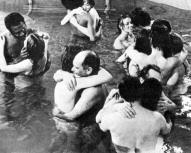 The first session of nude psychotherapy was held in 1967, at a nudist resort in California. It was the brainchild of radical therapist and ordained minister Paul Bindrim who made headlines around the world with events intended to enhance emotional connectedness and dismantle body-image hangups.
The first session of nude psychotherapy was held in 1967, at a nudist resort in California. It was the brainchild of radical therapist and ordained minister Paul Bindrim who made headlines around the world with events intended to enhance emotional connectedness and dismantle body-image hangups.
Despite the massive interest at the time, ‘nude psychotherapy’ would have largely disappeared from the history of psychology if it weren’t for a truly amazing article by historian Ian Nicholson, published in the Journal of the History of the Behavioral Sciences, which you can read in full as a pdf.
Nude psychotherapy grew out of the 60s encounter group movement, where people seeking personal development would meet for intense one-off group therapy sessions where emotional honesty and group amplification led to powerful personal experiences.
The popularity of these events created a demand for groups that delivered ever more striking emotional experiences with the most intense being the marathon 24 or 36 hour encounters. Bindrim took the concept one step further and created the concept of nude psychotherapy.
He was partly inspired by the founder of humanistic psychology, the famous and significantly more respectable Abraham Maslow, who had an established but purely theoretical interest in whether nudity would make people in therapy “an awful lot freer, a lot more spontaneous, less guarded”.
Bindrim talked the language of spontaneity and authenticity, but as Nicholson notes, the groups were carefully planned:
Bindrim was convinced that the “natural state” of humanity had been lost and that disrobing would peel back layers of modernist artifice and alienation and reestablish a healthy connection with one’s body and the true self. Ironically, although a self-declared enemy of the inauthentic, Bindrim sought psychological deliverance through the very artifice he decried. Far from being spontaneous returns to “nature,” his marathons were carefully orchestrated performances of psychological ingenuity and financial opportunism…
Bindrim began this process by employing familiar encounter group techniques. Participants were invited to “eyeball” each other (stare into each other’s eyes at close range) and then to respond in some physical way (hugging, wrestling, etc.). After this ice-breaker, participants disrobed in the dark to musical accompaniment before joining a small circle to perform a “meditation-like” hum. This process, Bindrim felt, gave rise to the “feeling of being all part of one human mass”
The sessions included role-playing traumatic experiences and touching exercises in a swimming pool, but perhaps most notable was an exercise called “crotch eyeballing”, designed to dispel guilt about the body, in which participants were instructed to look at each others genitals and disclose the sexual experiences they felt most guilty about while lying naked in a circle with their legs in the air.
As well as select groups of participants, Bindrim invited the press, and nude psychotherapy was featured in some of the world’s biggest publications. The Life magazine online archive has two photos from a feature on one of the events.
Psychology Today apparently featured nude therapy on its front page where a big breasted young woman was accompanied by the headline “The Quest for the Authentic Self” (which is a phrase I’ve noticed works great on almost any semi-pornographic picture, by the way).
Although the press generally took a snigger snigger approach to the proceedings, nude psychotherapy garnered a great deal of mainstream interest and headlined professional conferences and journals – even pushing Milgram’s famous ‘lost letter’ study to the back pages of American Psychologist.
It was subject to a professional ethics enquiry at one point, but because of all the nudity and free love already happening in 60s America, the committee couldn’t decide whether it violated the “the social codes and moral expectations of the community”. No serious action was taken and the attention helped raise the profile of the off-beat therapy.
Bindrim’s ego grew in proportion to the excitement and soon he was claiming nude psychotherapy could cure everything from suicidal tendencies to arthritis, before transforming it into ‘aqua energetics’ – a “theoretical framework that could address the totality of human experience”.
Although the Bindrim maintained a lively private practice, he faded into obscurity, and by the time he died he was remembered by a single snarky obituary in the LA Times.
I really can’t do justice to Ian Nicholson’s brilliant article on nude psychotherapy here, which is as well written as it is well researched. A fascinating insight into a forgotten (dare we say, repressed?) chapter of American psychology.
A friend of mine was in the early days of his career (psychologist) during the tail end of all this… he used to refer to it as “planned spontaneity” and mentioned several times how guys would use a demand for openness and honesty to persuade women into sexual encounters.
Thanks for your interest and for your kind remarks – much appreciated.